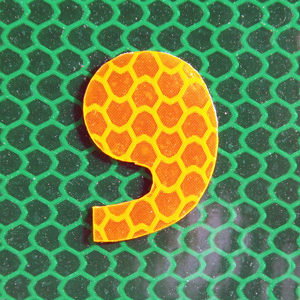
Source: comma, Leo Reynolds, Flickr
You now know that an independent clause is one that can stand alone. A dependent clause, on the other hand, can’t. In fact, it cannot even call itself a complete thought. A dependent clause needs additional information to make sense.
Always keep in mind that once you put a subordinating conjunction at the beginning of a clause, it is immediately demoted to a group of words in search of another clause to complete it. You need to either remove the subordinating conjunction or combine the subordinate clause with an independent clause that can stand on its own two feet. Also, you should know that subordinating conjunctions can be placed in the middle of a sentence, as well as in the beginning.
You could combine the following clauses, for example, to make them complete:
Clauses: if people just look (DC, dependent clause)
there is love all around (IC, independent clause)
Revision: There is love all around if people just look.
Clauses: while Chris played his violin (DC)
the dog hid in the kitchen whimpering (IC)
Revision: The dog hid in the kitchen whimpering while Chris played his violin.
Clauses: when I write (DC)
I feel like an armless chair (IC)
Revision: When I write, I feel like an armless chair.
Look back at that last revision. Apart from its unclear meaning, did you notice anything different from the previous revisions?
The last example is the only one with a comma in the sentence. Aha! Why did we put a comma in the sentence when we combined it? Also, is it an accident that it is placed directly after the subordinate clause when I write? The other combined sentences contain subordinating conjunctions, all without commas. What makes this one so special?

Source: Conant Play-a-Thon 2013 55, Mike Miley, Flickr
The answer is fairly simple. We put a comma after when I write because this subordinate (and dependent) clause begins the sentence. If we attach a subordinate clause at the end of an independent clause, however, we generally don’t need a comma. Read the following examples:
Tanya did poorly on her math test because she had forgotten to study.
Jorge spent his class time reading music since the band director had given him a new part to memorize.
In the next set of examples, the subordinate clause begins a sentence, so you do need a comma.
| Because she forgot to study, Tanya did poorly on her math test. |
| Since the band director gave him a new part to memorize, Jorge spent his class time reading music. |
| After we finish our homework, we should go hiking. |
| Although I like school, sometimes I wish we still had recess. |
| Unless he calls me first, I won’t ever speak to him again! |
Now, read the sentences below and inspect them for correct punctuation. If a comma is missing, click on the word it should follow in the sentence. If you choose correctly, a comma will appear. You should find three places that need commas. When you’re finished, you may move to the next section.

Source: Artist’s rendering of the Voyager spacecraft, NASA, NASA.gov
